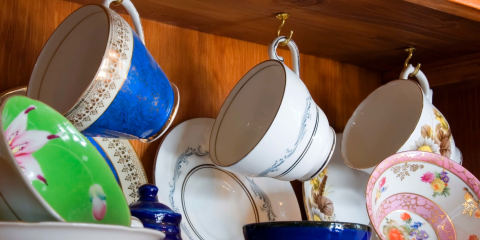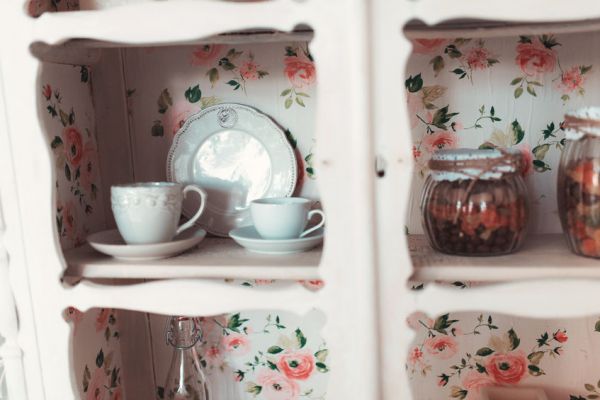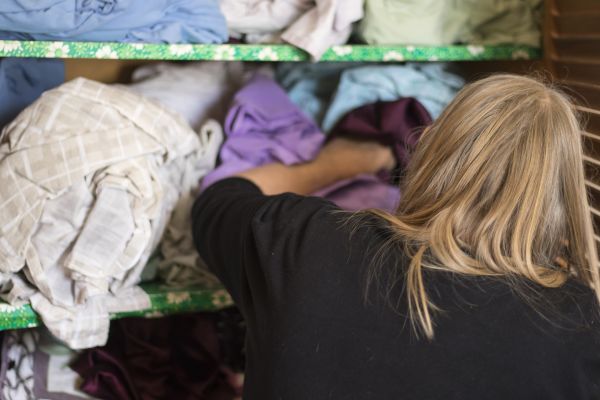Sometimes called china closets, breakfronts, or hutches, china cabinets are large, heavy pieces of furniture with parts that need to be packed and transported carefully. On top of that, they’re often filled with fragile, sentimental, and valuable items that require their own special considerations when you’re packing up to move. If you’ve never had to move a china cabinet before—and sometimes even if you have—it can be tricky to work out where to begin without some guidance.
If you’re using a professional moving company, ask if they provide packing services. If they don’t, follow these steps to pack your china cabinet safely:
1. Remove the contents
Before you being disassembling your china cabinet, carefully remove and relocate or pack its contents. Since china cabinets often contain delicate, valuable items and family heirlooms, take extra precautions when packing them to ensure they arrive in one piece.
- Securely tape the bottom of the box, so it doesn’t tear open during the move and break the contents.
- Put a layer of crumpled packing paper on the bottom of the box.
- Wrap each item individually in packing paper or bubble wrap.
- Pack items into small boxes and label them FRAGILE, indicating which side should face up, what the contents are, and where they belong.
- Fill any gaps with packing paper so the contents don’t shift around and break during transport.
2. Take apart your china cabinet
Disassembling all removable parts is one of the best ways to safely pack and transport your china cabinet and ensure it arrives undamaged. To do this, you will need:
- An assistant to help you handle glass pieces and keep things from falling while you unscrew them
- A screwdriver
- Labelled container for screws, hinges, and any other small parts you may remove
- Work gloves
- Bubble wrap
- Packing paper
- Moving blankets
- Packing tape
| TSI TIP: Don’t place bubble wrap directly against the glass or delicate wood finishes—this can leave marks. Instead, wrap the glass or wood with packing paper first and then layer bubble wrap overtop, with the bubbles facing in. |
Gather everything you need, put on your work gloves, and follow these 4 steps to safely disassemble your cabinet:
Step 1 - Remove the doors
Unscrew the doors one at a time and remove them from their hinges.
| PACKING TIP: If the knobs are removable, remove them to make the doors easier to pack. Immediately place them with the door screws in a bag or container, label it with their purpose or location, and tape them to the inside of the cabinet in a safe spot or, if you are planning to store all of the screws together, place them in a larger bag labelled “china cabinet”. |
Wrap the door in layers, starting with packing paper, then bubble wrap. Finish them off by wrapping them in a moving blanket or specialty double-thick box and packing tape. Label the box, or the tape if you’ve used a moving blanket.
Step 2 - Remove the shelves
If your china cabinet has built-in shelves, you can skip this step. If your cabinet has adjustable or removable shelves, they need to be taken out. If they are made of glass, be especially careful when removing them.
|
How to pack glass shelves Wrap each shelf separately in the same layer sandwich that you used to wrap the doors—packing paper and bubble wrap—and then wrap them together in a moving blanket and secure it with packing tape before placing it in a box. |
Step 3 - Remove any drawers
This will make the china cabinet lighter and much easier to carry. Wrap the drawers in moving blankets and label them with their designated location in the cabinet (top, middle, bottom, etc). If they are wrapped securely and their contents are not overly fragile, you may not need to pack up the contents separately.
Step 4 - Separate the upper and lower sections
If your china cabinet is a one-piece, you can skip this step. Otherwise, separate the sections by unscrewing the top from the base and gently removing it. Package, label, and tape all screws to the piece they belong to.
3. Wrap the cabinet
Place cardboard over any remaining glass that could not be removed. Wrap the entire cabinet with thick furniture blankets to keep it protected from scratches and dings, paying special attention to the corners, and tape it to hold it in place. Be careful not to get tape on any finished wood surfaces where it can cause damage.
4. Protect the legs
In most cases the legs will not be removable, so protecting them with packing paper, bubble wrap or moving blankets will be necessary.
If your china cabinet has especially ornate legs, you may want to go one step further and protect the legs with an extra layer of cardboard cut, folded, and taped around the layers of wrapping.
If the legs can be removed, detach them and wrap them in packing paper and bubble wrap or a moving blanket, and keep them with the cabinet.
Tips for moving & loading your china cabinet
With your cabinet all wrapped up and secured with tape or string, it’s ready to move. If you’ve decided not to hire professionals to transport your china cabinet, follow these tips:
- Always ask for assistance from a friend who is up to the task.
- Use proper lifting technique to prevent injury and accidents that could damage your cabinet—lift with your legs, not your back.
- To make the job easier, pick up some moving straps, or rent or borrow an appliance dolly. Just make sure the china cabinet is properly and securely attached to the dolly before you start moving it.
- Once it has been loaded into the truck, securely attach the china cabinet to the wall of the truck using strong ropes so it doesn’t slide around during transit and get damaged.
Conclusion
With fragile contents and delicate parts, packing china cabinets to prevent damage can seem like a daunting task, especially if it’s been a while between moves. Just remember to remove the contents, disassemble as much of the china cabinet as possible, carefully wrap and pack the individual pieces, and don’t hesitate to reach out for professional help if you need it.




